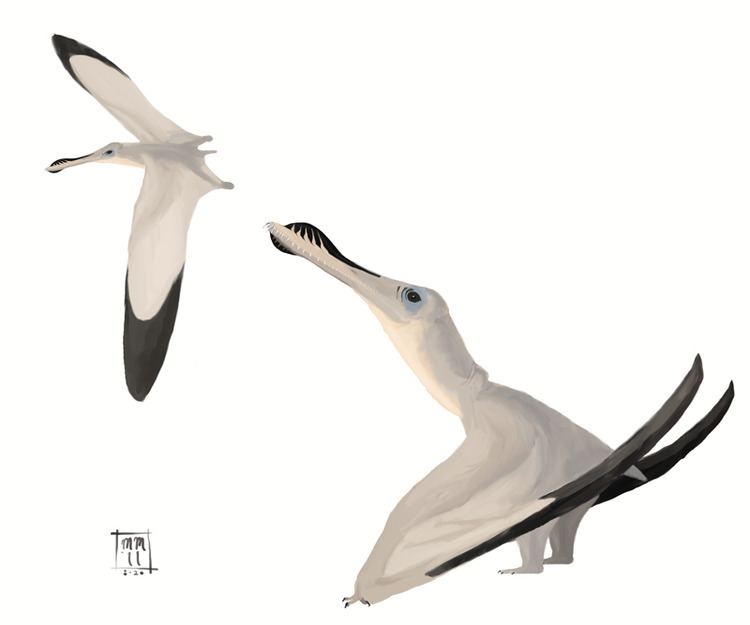Rank Genus | Phylum Chordata | |
Similar | ||
Anhanguera (meaning "old devil") is a genus of pterodactyloid pterosaur known from the Early-Cretaceous (Albian age, 112Ma) Santana Formation of Brazil. This pterosaur is closely related to Ornithocheirus, and belongs in the family Ornithocheiridae within its own subfamily, Anhanguerinae.
Contents

Description
Anhanguera was a fish-eating animal with a wingspan of about 4.6 m (15 ft). Like many other ornithocheirids, Anhanguera had rounded crests at front of its upper and lower jaws, which were filled with angled, conical but curved teeth of various sizes and orientations. Like many of its relatives, the jaws were tapered in width, but expanded into a broad, spoon-shaped rosette at the tip. It is distinguished from its relatives by subtle differences in the crest and teeth: unlike its close relatives Coloborhynchus and Ornithocheirus, the crest on the upper jaw of Anhanguera did not begin at the tip of the snout, but was set farther back on the skull. Like many ornithocheiroids, (most notably the pteranodonts but also in ornithocheirids such as Ludodactylus) Anhanguera had an additional crest protruding from the back of the skull. However, it was reduced to a small, blunt projection in these animals.

A study in 2003 showed that Anhanguera held its head at an angle to the ground due to its inner ear structure, which helped the animal detect its balance.
Classification and species
There are three species of Anhanguera. A. santanae, A. blittersdorfi and A. piscator* are known from several fragmentary remains (including skulls) from the Romualdo Formation calcareous concretions (Santana Group) of Ceará and Pernambuco states of Brazil. *The well-known species A. piscator has been redescribed by Veldmeijer (2003) and proponed to belong to the genus Coloborhynchus but a late cladogram from Andres and Myers (2013) placed this taxon back to Anhanguera.
Species
Species which have been assigned to Anhanguera by various scientists include:
Below is a cladogram showing the phylogenetic placement of this genus within Pteranodontia from Andres and Myers (2013).
"Pricesaurus"
In 1986, Rafael Gioia Martins-Neto reported the find of a pterosaur that he named "Pricesaurus megalodon" in a lecture during the 38th Reunião Anual da Sociedade Brasileira para o Progresso da Ciência at São Paulo. The abstracts of the congress were subsequently published that year in the magazine Ciência e Cultura. The generic name honours Llewellyn Ivor Price. The specific name is derived from Greek μέγας, megas, "large", and ὀδών, odon, "tooth". The species was based on two syntypes that Martins-Neto considered to have originated from a single individual animal, even though he had separately acquired them from commercial fossil dealers in two nodules: specimen CPCA 3592, a 9 centimetres (3.5 in) long point of a snout, and specimen CPCA 3591, an 18 centimetres (7.1 in) long middle part of a skull. Pricesaurus is thus exclusively known from cranial material. Both specimens were probably found in the Romualdo Member of the Araripe Basin and both are part of the collection of the Centro de Pesquisas Paleontológicas da Chapada do Araripe.
Martins-Neto provided a diagnosis of four distinctive traits: the breadth of the premaxillae; the closely positioned teeth; the deep premaxillary tooth sockets; and the rounded front of the fenestra nasoantorbitalis. However, in 1988 Alexander Kellner concluded that Pricesaurus was a nomen vanum, primarily because the specimens almost certainly represented different individuals. According to Kellner, the snout was from a larger animal than the middle part of the skull. In addition, the diagnosis did not contain true autapomorphies.
In 2012, a publication by Felipe Lima Pinheiro and colleagues presented the first detailed study of the specimens. It was concluded that the fossils indeed came from different individuals, even though their size was not necessarily incompatible. The snout showed that the fifth and sixth tooth pairs are smaller than the fourth and seventh, making the specimen indistinguishable between Anhanguera blittersdorffi and Anhanguera piscator, which show the same tooth pattern. Both specimens were referred to as Anhanguera sp. Pinheiro et al. noted that Pricesaurus is technically a nomen nudum because it was named in an abstract.
